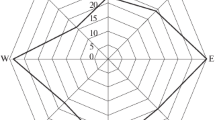Abstract
The author carried out an ecological survey of the saddle backed tamarin (Saguinus fuscicollis) in the Pando, northern Bolivia, from July to December 1979. It was found thatS. fuscicollis formed a family group consisting of two to seven individuals and spent almost all the daytime in moving to forage insects, although it fed mainly on fruits of the family Moraceae. Primary forest was preferred for sleeping sites, whereas the animals spent more hours in secondary forest than in primary forest in their home range. Marking sites were concentrated in the center of the home range but encounter behaviors tended to take place near the borderlines of the home range. It was also found that infants began feeding on fruit at about 5 weeks of age, whereas they shared insects obtained by their mothers until about 10 weeks of age.
Similar content being viewed by others
References
Bernstein, I. S., P. Balcaen, L. Dresdale, H. Gouzoules, M. Kavanagh, I. Patterson &P. Neyman-Warner, 1976. Differential effects of forest degradation on primate populations.Primates, 17: 401–411.
Box, H. O. &J. M. Morris, 1980. Behavioural observations on captive pairs of wild caught tamarins (Saguinus mystax).Primates, 21: 53–65.
Castro, R. &P. Soini, 1978. Field studies onSaguinus mystax and other Callitrichids in Amazonian Peru. In:The Biology and Conservation of the Callitrichidae,D. G. Kleiman (ed.), Smithsonian Inst. Press, Washington, D.C., pp. 73–78.
Dawson, G. A., 1978. Composition and stability of social groups of the tamarin,Saguinus oedipus geoffroyi, in Panama: Ecological and behavioral implications. In:The Biology and Conservation of the Callitrichidae,D. G. Kleiman (ed.), Smithsonian Inst. Press, Washington, D.C., pp. 23–37.
Epple, G., 1967. Vergleichende Untersuchungen über sexual- und Sozialverhalten der Krallenaffen (Hapalidae).Folia Primatol., 7: 37–65.
Gibbons, Jr., E. F. &E. W. Menzel, Jr., 1980. Rank orders of arising, eating and retiring in a family group of tamarins (Saguinus fuscicollis).Primates, 21: 44–52.
Haddow, A. J., 1952. Field and laboratory studies on an African monkey.Proc. Zool. Soc., London, 122: 297–394.
Hershkovitz, P., 1977.Living New World Monkeys (Platyrrhini) with an Introduction to Primates, Vol. 1. Univ. of Chicago Press, Chicago and London.
Izawa, K., 1975. Foods and feeding behavior of monkeys in the upper Amazon basin.Primates, 16: 295–316.
————, 1976. Group sizes and compositions of monkeys in the upper Amazon basin.Primates, 17: 367–399.
————, 1978. A field study of the ecology and behavior of the black-mantle tamarin (Saguinus nigricollis).Primates, 19: 241–274.
————, 1979. Studies on peculiar distribution patterns ofCallimico.Kyoto Univ. Overseas Research Reports of New World Monkeys, I: 1–19, Primate Research Inst., Kyoto Univ., Inuyama.
———— &M. Yoneda, 1981. Habitat utilization of nonhuman primates in a forest of the western Pando, Bolivia.Kyoto Univ. Overseas Research Reports of New World Monkeys, II: 13–22, Primate Research Inst., Kyoto Univ., Inuyama.
Moynihan, M., 1976. Some behavior patterns of platyrrhine monkeys. II.Saguinus geoffroyi and some other tamarins.Smithsonian Contrib. Zool., 28: 1–77.
Nelson, T. W., 1975. Quantitative observations on feeding behavior inSaguinus geoffroyi (Callithrichidae, Primates).Primates, 16: 223–226.
Neyman, P. F., 1978. Aspects of the ecology and social organization of free-ranging cotton-top tamarins (Saguinus oedipus) and the conservation status of the species. In:The Biology and Conservation of the Callitrichidae,D. G. Kleiman (ed.), Smithsonian Inst. Press, Washington, D.C., pp. 39–71.
Pook, A. G. &D. Pook, 1982. Polyspecific association betweenSaguinus fuscicollis, Saguinus labiatus, Callimico goeldii and other primates in North-western Bolivia.Folia Primatol., 38: 196–216.
Thorington, R. W., Jr., 1968. Observations of the tamarinSaguinus midas.Folia Primatol., 9: 95–98.
Voget, J. L., 1978. The social behavior of a marmoset (Saguinus fuscicollis) group. II. Behavior patterns and social interaction.Primates, 19: 287–300.
Yoneda, M., 1980. Ecology of wild Weddell's saddle-backed tamarins and red-chested moustached tamarins.Monkey, 171/172: 32–37. (in Japanese)
————, 1981. Ecological studies ofSaguinus fuscicollis andSaguinus labiatus with reference to habitat segregation and height preference.Kyoto Univ. Overseas Research Reports of New World Monkeys, II: 43–50, Primate Research Inst., Kyoto Univ., Inuyama.
Author information
Authors and Affiliations
About this article
Cite this article
Yoneda, M. Ecological study of the saddle backed tamarin (Saguinus fuscicollis) in Northern Bolivia. Primates 25, 1–12 (1984). https://doi.org/10.1007/BF02382290
Issue Date:
DOI: https://doi.org/10.1007/BF02382290




